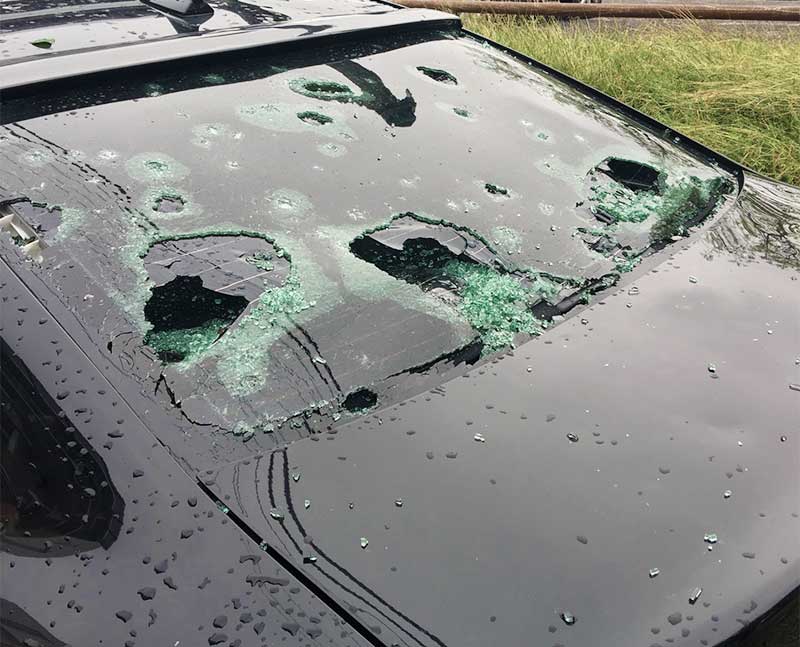
The Challenges of Auto Hail Repair: Not a DIY Project
According to the National Oceanic and Atmospheric Administration, there were 5,396 major hailstorms in the United States last year. Hail damage is a frequent problem for car owners and one that cannot be anticipated. If your vehicle has been dinged in a hailstorm, you are probably considering options for hail damage repair. Do-it-yourself internet instructions for all types of projects have been increasing in popularity. If you are generally handy with repairs, this option may be tempting. After all, minor dents and dings appear to be easy to fix. However, repairing a dent in your vehicle is not an easy task at all, not to say, fixing hundreds of it – it’s quite normal to have hundreds of dents from a hailstorm. In fact, you could even cause greater damage to your vehicle’s surface or paint job. Think twice about trying to repair it yourself. There are new methods of dent repair available that are both cheap and efficient. With proper insurance policies and our deductible coverage, you may not pay anything out-of-pocket. And some minor damage could be fixed within a couple of days. Before venturing out on your own dent repair endeavor, take a look at the information below. Having a professional repair your vehicle can be affordable and seamless. And it will give you the assurance that the job is done properly. Auto Hail Repair Options There are two types of professional hail dent repair. There is a conventional method and what is known as paintless dent repair, or PDR. Traditional dent repair involves using filler on the dent or ding, then repainting it. The technician grinds off the external paint, then bangs the metal back to its approximate original form. They then apply putty to smooth out the surface. Once the putty is dry, the technician sands it, then applies primer, base paint, and a final layer of paint. These processes can take a lot of money and a long time to complete. However, the traditional method of repair is necessary for some dents. Paintless dent repair is a process where the technician removes the paneling inside the car opposite the damage. They then use specialized equipment to reshape the metal back into its original form. The tools leverage rods and body picks to push it back into its original shape. Without sanding/grinding/painting, PDR can produce an exact pre-dent texture and contour that keeps your original paint intact. Advantages of PDR Although it involves a meticulous process by experienced technicians, PDR is usually much faster than traditional dent repair. Using the conventional method, severe hail damage could take a few weeks to over a month to finish. PDR requires fewer steps – at StormWise, most of our auto hail repair is done within two weeks. Since PDR requires fewer materials and less labor, it can be much more affordable than conventional dent repair. Traditional methods can cost well over tens of thousands of dollars. Whereas, PDR allows for the efficient repair of minor dents and dings for a fraction of the cost. Another primary reason to opt for PDR is that it restores the surface of your vehicle to its original form. Although traditional dent repair will mask any damage to the naked eye, there is an advantage to PDR beyond aesthetic reasons. Returning the vehicle to its original state can help it retain its value. Depending on the extent of the damage, this could mean a big difference in the amount of money you receive when you can resell your car. Finally, since the PDR method does not use paints and chemicals, it is more environmentally friendly than conventional repair. Variables That Determine Repair Method A big deciding factor regarding which methods can be used is the condition of the paint. It must be intact for PDR to work since the process involves no repainting of the surface. The size of the dent also can be a determining factor. Major dents usually require the use of traditional methods, but not always. If the metal has been stretched significantly, then it may not be possible for PDR to return it to its original form. In these cases, the conventional method of repair is necessary. A final determining factor is the material of the damaged part. PDR is an excellent choice for dented metal, but not possible for plastic. Other Considerations It is easy to find a repair shop that can fix your car using conventional dent repair techniques. But finding a PDR specialist could end up saving you a lot of time and money. According to the Insurance Information Institute, hail damage claims in the U.S. average between $8 and $14 billion every year. If you have comprehensive insurance coverage on your vehicle, it covers weather-related damage like hail. Get a quote from a specialized hail repair shop or use an online hail damage repair cost calculator before you file a claim. When you contact us at StormWise, we will handle the insurance process for you. Don’t Rely on DIY Auto hail repair may seem like a simple process, but it is best left up to professionals. Given the available options like PDR and the insurance coverage, why risk doing a poor job repairing the dent yourself or even causing greater damage? Most prominent repair shops provide lifetime guarantees so that you know the repair will be done right. Contact a reputable hail repair shop for a free estimate. You have nothing to lose by determining what a professional repair will cost. You may be surprised how economically and efficiently an experienced company can fix your dent and get you back on the road.














 Auto hail
repair
Auto hail
repair
 Hail
damage cost calculator
Hail
damage cost calculator  Before/After
Before/After
 PDR cost
101
PDR cost
101
 About
StormWise
About
StormWise
 reviews
reviews  Articles
Articles  FAQs
FAQs
 resource & contact
resource & contact